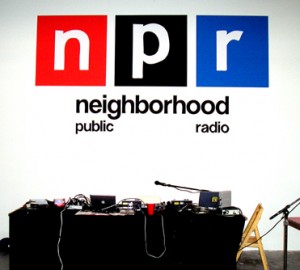March 1st, 2011 — Briggs Chapters Tagged audio, Briggs ch. 7, NPR, radio, reporter, sound, W.A.M.U 88.5 Youth Voices
Audio can compliment an article and make it more compelling. It can create presence, emotions and atmosphere that words or pictures cannot express.

NPR
Journalists can use radio to do the following:
Radio stories have the following elements:
- Interviews and voice-overs
- Natural or environmental sound
- Imported sound clips, including music
There are many recorders and mics of varying prices that journalists can use.
I was an intern at W.A.M.U’s Youth Voices Program. Here’s a link to my radio story:
March 1st, 2011 — Briggs Chapters Tagged Briggs ch. 6, compressing, copyright, ownership, photographs, photography, photos, pixels, ppi, resolution
Photography has become much easier, with all the technology around. But, since everyone can pull out their phone or digital camera and snap a couple pictures, the quality of those photographs have gone down.
All journalists need to know how to work a camera and how to choose a picture that will show more than anything they can put into words.
This chapter also went over Ownership, copyright, creative commons, and fair use.
I have the most common digital camera (a point-and-shoot) but there is also another type — DSLR.

DSLR camera
Some helpful definitions:
- Pixel — stands for PICTure ELement and is a visual representation of data in an image or graphic.
- Megapixel — represents one million pixels.
- Resolution — the number of pixels in an image. 72 is the number of ppi (pixels per inch) that photographs need to be when displayed on a computer because that is the same number of ppi that a computer screen displays. Photographs in newspapers and magazines are around 200-300 ppi and should be compressed when put online.
- Compressing — using a computer program to squeeze the image, omitting the pixels that aren’t necessary and making the files smaller (in bytes) without sacrificing the overall quality.
When taking pictures these elements are very important:
- Lighting
- Movement
- Proximity
- The subject’s comfort
- Take more photos than you think you need
- Editing
- How to present them for maximum benefit
Photoshop is one of the most commonly used photo editing software.
February 22nd, 2011 — Briggs Chapters Tagged audio, Briggs Ch. 5, gearheads, light packers, mobile journalism, smartphones, Video
Mobile journalism was the main subject of this chapter.

Smartphones have become a helpful tool for many journalists.
- News organizations are tapping into mobile journalism to compliment their news, especially during a breaking news story.
- A couple questions to keep in mind include:
- Will the audience benefit if we can take them there?
- Will the journalism be better if it’s done on location and with urgency?
- Can this event be effectively communicated in small chunks over time?
- Will sound reporting or video footage, turned around quickly, help people understand the story?
- Criminal and civil trials, breaking news of all types, public gathering, sporting events and grand openings are great places to use mobile journalism.
- There are two types of mobile reporters: gearheads and light packers.
- Gearheads use all the equipment available such as a laptop, tripod, audio recorder, etc. when they’re in the field (which is nearly 24/7).
- Light packers aren’t in the field as often and only need their smartphone with a camera, keypad and mobile internet.
- Mobile journalism publishing options include:
- Twitter
- FriendFeed
- Blogs and services like CoveritLive
- Qik, Kyte and Flixwagon (all mobile video services)
- Your audiences’ publishing capabilities
http://www.youtube.com/watch?v=csQZ3Dq4oxI
Libya protests caught on amateur video World news guardian.co.uk.
February 18th, 2011 — Blog Item Tagged social media, social media editor, social media tips, tech blog post, Zombie journalism
This
post included a transcript of an online interview Jenkins did.

Tweet
My takeaway:
- It is possible to over-tweet
- Tweeting for an organization is much different than tweeting for yourself.
- It is important to respond to your retweets or audience’s comments
- News elements of social media will be around past the fads like Twitter
- For organizations, Facebook can be more difficult than Twitter because the consumers are attracted through a promotion, etc. then they don’t interact again.
- When correcting a post, explain why because it gives you some transparency.

good vs. bad twitter

February 15th, 2011 — Briggs Chapters Tagged Briggs ch. 4, Briggs chapter 4, microblogging, shorty awards, twitter
Many journalists embraced microblogging sites, like Twitter, because it’s easy exposure, quick and provides a way to get feedback from readers or other journalists. Twitter is one of the most popular microblogging sites at the moment.

Twitter
In the past, people had to wait for journalists to report on events but now they can just microblog it. Microblogging has become a resource for many people. Companies use it to see how many mentions their product is getting. People can gain awareness of tragedies and breaking news in real-time. There is even an award for the best microblogging, as chosen by Twitter users. This is the Shorty Awards.

Shorty Awards
Microblogging also helps young journalists focus their writing since you can only write around 140 characters. Microblogging helps journalists since people can react to it and react quickly. Also, journalists can get to know their audience better since they can see exactly who is following them. However, some still use it as an RSS feed. Public interviews can also be conducted over Twitter and many journalists have said they have gotten tips from Twitter that have led to a story.
Here are some tips to keep in mind while Tweeting:
- Show personality
- Follow the 80-20 rule: 80 percent of your tweets should be tips or have value for the community, 20 percent should be self-promoting.
- Be informative
- Stay relevant
- Ask/answer questions
- Be instructive
- Include a link






